工程项目管理-英文课件-RiskManagement.ppt
项目管理英文PPT课件
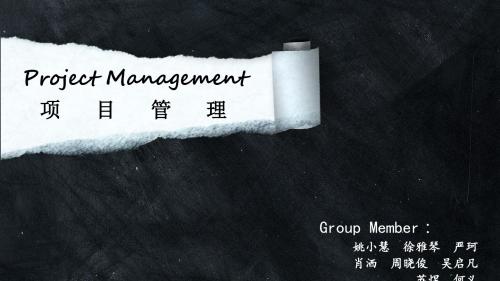
demands for project scope , time
, cost, risk and quality
• Satisfying stakeholders
with differing needs and
expectations
4
• Meeting identified
requirements
–Contingency plans are developed for the known risks.
–Ensures common understanding of the risks and their contingency
Sucre
Pass the credit card
Nika
Determine Available Resources What people, equipment, and money will you have available to you to achieve the project objectives? As a project manager, you usually will not have direct control of these resources, but will have to manage them through matrix management. Find out how easy or difficult that will be to do. Check the Timeline When does the project have to be completed? As you develop your project plan you may have some flexibility in how you use time during the project, but deadlines usually are fixed. If you decide to use overtime hours to meet the schedule, you must weigh that against the limitations of your budget. Create Your Baseline Plan Get feedback on your preliminary plan from your team and from any other stakeholders. Adjust your timelines and work schedules to fit the project into the available time. Make any necessary adjustments to the preliminary plan to produce a baseline plan. Request Project Adjustments There is almost never enough time, money or talent assigned to a project. Your job is to do more with the limited resources than people expect. However, there are often limits placed on a project that are simply unrealistic. You need to make your case and present it to your boss and request these unrealistic limits be changed. Ask for the changes at the beginning of the project. Don't wait until it's in trouble to ask for the changes you need.
工程项目管理-英文课件-Project Information Management.ppt
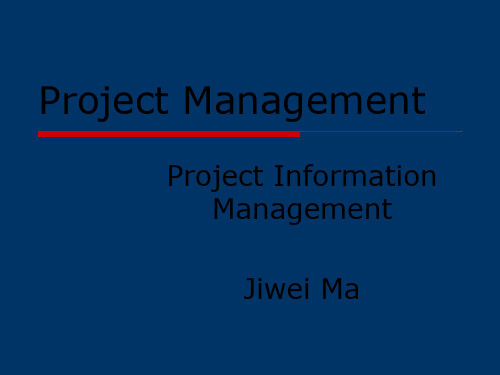
The PKM Info
News
General project news Summary Main aspects in one view Online reporting Task list, detailed reporting, project members, project description
Assure project information security and information exchange
Web-based Project Management
Computer network supported by Internet or Intranet based server Personalized and controlled access and authorization Centralized management of project information Individualized project information exchange environment highly-efficient project communication and collaboration environment for all project participants
Document management
Centralized management Individualized access
Project collaboration
Collaboration among all project participants Automatic control of procedures
Project Management
项目管理之风险管理(PPT)

可能带来的增减变化情况 ✓ 4、计算敏感性系数和临界点,确定敏感性因素
三、风险评价方法
风险评价是在不确定情况下 进行决策的一种量化的方法
决策树方法
工程项目风险基本概念
工程项目风险是指工程项目在设计、施工和竣工验 收等各个阶段可能遭到的风险,可将其定义为,在 工程项目目标规定的条件下,该目标不能实现的可 能性。
对建设工程项目风险的认识,要明确两个基 本点:
第一,建设项目风险大。 第二,参与工程建设的各方均有风险,但各方的风
险不尽相同。
《建设工程项目管理规范手册》中对项目风 险管理的定义是:项目风险管理是指通过风 险识别、风险分析和风险评价去认识项目的 风险,并以此为基础合理地使用各种风险应 对措施、管理方法、技术和手段,对项目的 风险实行有效的控制,妥善处理风险事件造 成的不利后果,以最少的成本保证项目总体 目标实现的管理工作。
Delphi法的特点是: ①匿名性,亦即背靠背。可以消除面对面带来的
诸如权威人士或领导的影响。
②信息反馈、沟通比较好。
③预测的结果具有统计特性。 应用德尔菲法时应注意: ①专家人数不宜太少,一般4~8人为宜; ②对风险的分析往往受组织者、参加者的主观因素
影响,因此有可能发生偏差; ③预测分析的时间不宜过长,时间越长准确性越差。
决策树法是因解决问题的工具是“树”而得名。 其分析程序一般是:
①绘制决策树图。 ②预计未来各种情况可能发生的概率。 ③计算每个状态节点的综合损益值。 ④择优决策。
图 决策树结构图
【例】为生产某种产品有两种方案,一是建设大厂,
项目管理课程资料(ppt 89页)(英文版)
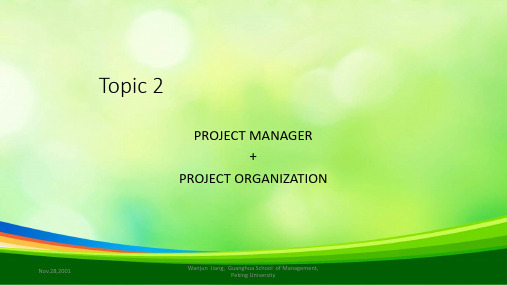
PROJECT MANAGER +
PROJECT ORGANIZATION
Nov.28,2001
Wanjun Jiang, Guanghua School of Management, Peking University
I. The Nature of Man
model about human behavior
• 2) The financial objectives of the project is based on the business case:(1)revenue from deliverables delivered to the client;(2) cost of team members’ labor;(3)cost of deliverables from suppliers;(4)all other project related cost
• There are no need, there only wants, desires. demands. If something is more costly, less will be demanded, than if it were cheaper. ----Cost/benefit analysis.
Nov.28,2001
Wanjun Jiang, Guanghua School of Management, Peking University
• Keep in mind:
• Almost all the people in the world act as REMMs, REMMs are everywhere ---- GAME between different parties----Try to understand what do your counterparty really want.
项目管理知识体系(英文)(ppt 33页)
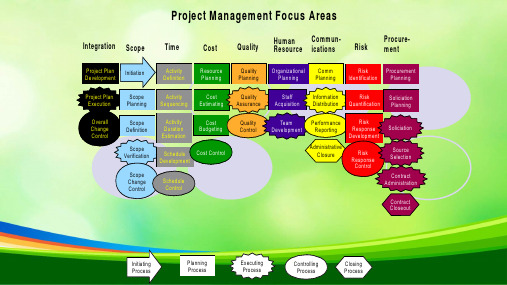
C ontract A dm inistration
P lanning
E xecuting
Scope Change C ontrol
S chedule C ontrol
C ost C ontrol
R isk R esponse
C ontrol
Q uality C ontrol
In itia tin g
Q uality P lanning
core fa c ilita tin g
Comm P lanning
R isk Id e n tific a tio n
Procurem ent P lanning
R isk Q uantification
R isk Response D evelopm ent
Project Management Focus Areas
Integration Scope
Tim e
Human Commun-
Procure-
Cost
Quality Resource ications
Risk ment
Project Plan D e ve lo p m e n t
Initiation
Corrective Action Plan Estim ate at Com pletion Lessons Learned
Schedule Updates C orrective Action Lessons Learned
Scope Changes Corrective Action Lessons Learned
R is k Response
S o lic ia tio n
项目管理培训课件:风险管理

项目风险管理规划的方法和工具
项目风险管理规划工作的结果是整个项目风险管理过程的战略性和指导性纲领,决定了项目组织的 风险管理活动全过程。早期的项目风险管理规划结果是一份初始项目风险管理计划文件,随着项目 的进展和风险管理的深入,项目风险管理规划需要不断的更新和完善。一般来说,项目风险管理规 划文件主要包括以下内容:
项目风险管理概述
项目风险管理包括规划风险管理、识别风险、开展风险分析、规划风险应对、实施风险应对和监督风 险的各个过程。
1. 规划风险管理:定义如何实施项目风险管理活动的过程。 2. 识别风险:识别单个项目风险,以及整体项目风险的来源,并记录风险
特征的过程,这通常在项目的需求阶段和概要设计阶段进行。 3. 定性风险分析:通过评估单个项目风险发生的概率和影响以及其他特征,
项目风险的管理规划
01
风险设想
02
指定风险应对备用方案
03
选择风险应对途径
04
指定风险管理计划
05
建立风险管理模板
06
确定项目风险数据库模式
01
项目范围说明书
04
沟通管理计划
项目风险的管理规划
项目风险管理规划的依据
02
成本管理计划
05
项目制约因素
03
进度管理计划
06
组织积累的相 关资源
项目风险管理规划的方法和工具
项目风险管理的目标是控制和处理项目风险,防止和减少损失,减轻或消除风险的不利影响,以最低 的成本取得对项目安全保障的满意结果,保障项目的顺利进行。
项目风险管理概述
项目风险管理是指通过风险识别、风险分析 和风险评估去认识项目的风险,并以此为基 础合理的使用各种风险应对措施、管理方法、 技术和手段,对项目风险实行有效的应对和 监控,妥善处理风险事件所造成的不利后果, 以最低的成本实现项目总体目标的实践活动 的总称。
riskmanagementPPT教学课件

© Intercultural Studies Group
Universitat Rovira i Virgili
Plaça Imperial Tàrraco 1
2020/12/10
43005 Tarragona Fax: (++ 34) 977 55 95 97
Success conditions are not in the text. High-risk texts are not “rich points”
(Agar).
© Intercultural Studies Group
Universitat Rovira i Virgili
Plaça Imperial Tàrraco 1
© Intercultural Studies Group
Universitat Rovira i Virgili
Plaça Imperial Tàrraco 1
2020/12/10
43005 Tarragona Fax: (++ 34) 977 55 95 97
2
Example 1
In a birth certificate, where can you make a mistake?
Translation as risk management
Anthony Pym
© Intercultural Studies Group
Universitat Rovira i Virgili
Plaça Imperial Tàrraco 1
2020/12/10
最新整理风险管理RiskManagement.ppt

标准化:交易单位
• 一张期权合约中标的资产的交易数量 • 股票期权:100 股股票 • 指数期权:标的指数执行价格与 100 美元的乘
积 • 期货期权:一张标的期货合约 • PHLX 的外汇期权:英镑期权 31 250 英镑,欧
元期权 62 500 欧元
标准化:行权价格
• 行权价格由交易所事先确定 • 当交易所准备上市某种期权合约时,首先根据
期权交易的特征和趋势
•日益增多的奇异期权:期权市场的激烈竞争和 普通期权利润空间的缩小。
•交易所交易产品的灵活化:灵活期权(Flex options)
•交易所之间的合作日益加强:一家交易所上市 的期权产品可以在其他交易所进行交易;或在一 家交易所交易,而在其他交易所平盘或交割;另 外有一些交易所则允许其他交易所的会员在本所 进行交易,等等。
标准化:红利和股票分割
➢ 早期的场外期权受红利保护:除权日后执行 价格要相应调整
➢ 现在的交易所期权不受红利保护,但在股票 分割或送红股时要调整
• 在 n 对 m (即 m 股股票分割为 n 股)股票分割之 后,执行价格降为原来执行价格的 m/n ,每一期权 合约所包含的标的资产数量上升到原来的 n/m 倍。
• 期权多头:支付期权费后,只有权利,没有义 务
• 期权空头:收取期权费后,只有义务,没有权 利
理解期权:双重买卖关系
期权的分类II:欧式期权与美式期权
期权的分类III:不同标的资产
• 股票期权 • 股价指数期权 • 期货期权 • 利率期权 • 信用期权 • 货币期权 • 互换期权 • ETF 期权 • 复合期权等
• 有些交易所规定期货期权中期权头寸与相应的 期货头寸合并计算
买卖指令
➢买入建仓,即买入一个期权,建立一个新头寸; ➢卖出建仓,即卖出一个期权,建立一个新头寸; ➢买入平仓,即买入一个期权,对冲原有的空头头寸 ; ➢卖出平仓,即卖出一个期权,对冲原有的多头头寸 ; ➢备兑开仓,是指投资者在持有足额标的证券的基础 上,卖出相应数量的认购期权合约。 ➢备兑平仓,是投资者持有备兑持仓头寸时,申请买 入相应期权将备兑头寸平仓的指令。
工程项目管理英文ProjectProcurement精品PPT课件
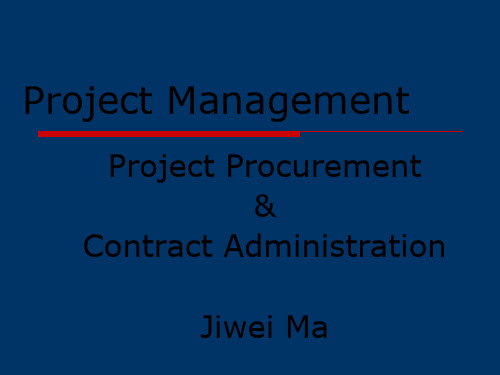
Project Procurement Concept
Definition
Project management tasks to deal with part of the project's scope of work which will be bought from another organization, sometimes the result of company teaming arrangements, but most typically resulting from contracting or subcontracting project scope.
Temporarily established organization
Mature organization
Short-term cooperation
with stabilized position Mostly low-volume quantity
Long-term cooperation Usually customized product or
Project Procurement Concept
Definition Project procurement and operation
procurement Project procurement categories Types of contract Basic procedure of project
Project Procurement Concept
Types of contract
Lump sum contract
Customized product or complicated system
项目管理知识体系概览课件(ppt 33页)(英文)
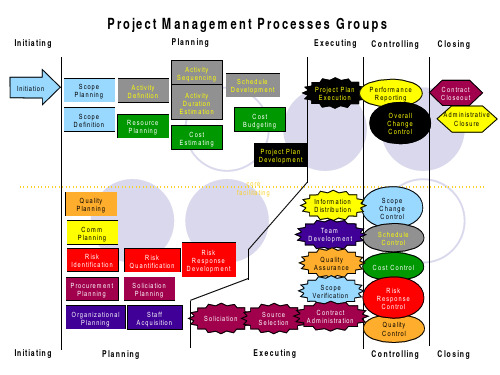
P lanning
E xecuting
Scope Change C ontrol
S chedule C ontrol
C ost C ontrol
R isk Response
C ontrol
Q uality C ontrol
C ontrolling
C losing
Q uality M gm t Plan Com m un Sources of Risk
O perational Defn M gm t Plan Potential RiskEvents
C h e c k li
Inputs to other processes
WBS
Resource P la n n in g
R esource R equirem ents
Planning
A c tiv ity S e q u e n c in g
Project Netw ork Diagram Activity List Updates
S c h e d u le Developm ent
Initiating
Initiation
Project Charter Project M gr ID'd/Assigned Constraints / Assum ptions
Project M anagem ent Processes Groups
Core
Scope P la n n in g
P roject P lan D evelopm ent
P erform ance R eporting
O verall Change C ontrol
工程项目管理英文课件
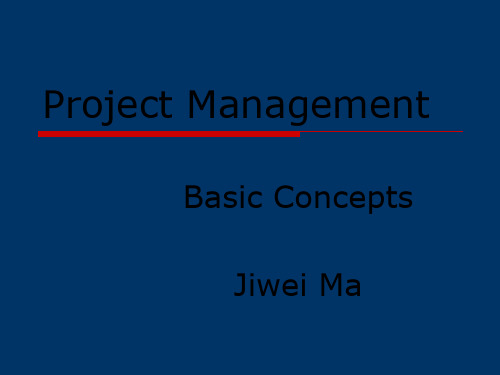
Subprojects Functional subsystems Single objects
Effort
Number of personnel and various resources involved
Objective
Requirement of certain quality standard with limited time and money
Specific
Different from all previous product or service
Decision Making
Decision Design Making Preparation
Network Diagram
TIME
Closeout
Operation
Implementatio n
Construction
Design
Construction Project Phasing
Acceptance Start up
Construction
Construction Document Design Development Preliminary Design Design Specification Feasibility Study Project Proposal
Project Management
Basic Concepts Jiwei Ma
项目管理培训讲义英文版(ProjectManagementpptinEnglish)

项目管理培训讲义英文版(ProjectManagementpptinEnglish)Knx ConsultingMark Yuan , PMP/ME Jun 2017 @ Hong Kong MarkYuan05@/doc/478507516.html, 学员版讲义,仅供参考。
完善及更新甚不如讲师版讲义To provide with the knowledge and tools to perform professional project management in your day-to-day work environment;To enhance the practical soft skills on team development, stakeholders and communication management.MarkYuan05@/doc/478507516.html, 学员版讲义,仅供参考。
完善及更新甚不如讲师版讲义Day-2:Executing & Controlling - Team Development- Quality- Performance- Changes- Life CycleClosing ProjectWrap-upDay-1:?Introduction ?Initiating Project ?Planning Project - Scope - Schedule - Cost - Resource & Comm - Risk MarkYuan05@/doc/478507516.html, 学员版讲义,仅供参考。
完善及更新甚不如讲师版讲义Mark YuanA lifetime educator and management advisorl PMI Member and professional trainerl Master's degree from the UBC (Canada)l Prj specialist in Bell (Canada, 2007~2009)l Product Manager in Fujitsu (China, 1998~2005)Clients: IBM, HP , eBay, NEC, Daimler (Mercedes-Benz), Schneider,ThyssenKrupp, Siemens, iSoftStone, ITW, Honeywell, Fujitsu, CIMC Raffles, Jinan Software Park, Bell Canada, VanCitySaving Credit Union, BestBuy, BC Hydro, Delta Horizon, 360 Network, WWF(World Wildlife Fund)v Namev Team Leaderv Case StudyMarkYuan05@/doc/478507516.html, 1960s:mass production, focus on productivity1970s:quality management1980s:product diversification1990s:customization2000s:change and competition学员版讲义,仅供参考。
项目管理Project management课件Chapter 7 Slides_Risk Management and Project Failure

RISK MANAGEMENTChapter 7CHAPTER 7LEARNING OBJECTIVESAfter completing this chapter, you should be able to:1.Define project risk.2.Recognize four key stages in project risk managementand the steps necessary to manage risk.3.Understand five primary causes of project risk and fourmajor approaches to risk identification.4.Recognize four primary risk mitigation strategies.5.Explain the Project Risk Analysis and Management(PRAM) process.QUESTIONS TO CONSIDER IN RISK MANAGEMENTWhat is likely to happen (the probability and impact)?What can be done to minimize the probability orimpact of these events?如何根据现状选择合适的方案应对风险What cues will signal the need for such action(i.e., what clues should I actively look for)?What are the likely outcomes of these problems and my anticipated reaction?RISK MANAGEMENTProject risk –an uncertain event or condition that, if it occurs, has a positive or negative effect on one or more project objectives such as scope, schedule, cost, or quality.Risk = (Probability of Event) * (Consequences of Event)Risk management –the art and science of identifying, analyzing, and responding to risk factors throughout the life of a project and in the best interest of its objectives.FOUR STAGES OF RISK MANAGEMENT1.Risk identification2.Analysis of probability and consequences减弱3.Risk mitigation strategies4.Control and documentationRISK FACTOR IDENTIFICATION Brainstorming meetingsExpert opinionPast historyMultiple (or team based) assessmentsRISK IMPACT MATRIX (FIGURE 7.5)RISK MITIGATION STRATEGIES∙Accept∙Minimize∙Share∙Transfer∙Contingency Reserves ∙Task contingency∙Managerial contingency ∙Insurance ∙Other Mitigation Strategies∙Mentoring∙Cross training∙Control and Documentation∙Change managementCONTROL & DOCUMENTATION Helps managers classify and codify risks, responses, and outcomesChange management report system answers:∙What?∙Who?∙When?∙Why?∙How?NINE PHASES OF RISK ASSESSMENT1.Define2.Focus3.Identify4.Structure5.Clarify ownership of risks6.Estimate7.Evaluate8.Plan9.ManageSUMMARY1.Define project risk.2.Recognize four key stages in project riskmanagement and the steps necessary tomanage risk.3.Understand five primary causes of project riskand four major approaches to risk identification.4.Recognize four primary risk mitigationstrategies.5.Explain the Project Risk Analysis andManagement (PRAM) process.。
工程项目管理-英文课件-ProjectProcurement.ppt

7. Vendor Management
Describe what steps the project team will take to ensure that the vendor provides all of the products and/or services (and only the products and/or services) that were agreed upon, and that appropriate levels of quality are maintained..
Continuous on-going production environment Mature organization with stabilized position Long-term cooperation Mostly bulk quantity purchase Minimized nonstandard product
8. Project Procurement Plan / Signatures
Project Name: Project Manager:
I have reviewed the information contained in this Project Procurement Plan and agree: Name Role Signature Date
Planning of Project Procurement
Content of project procurement plan
第十三章 工程项目风险管理 《工程项目管理》PPT课件
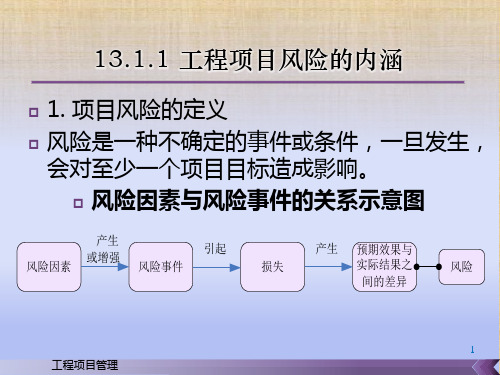
风险评估过程框架
搜集资料
客观统计资料
主观估计资料
分析资料
估计项目 风险潜在影响
估计项目风险 概率分布
评估项目风险潜在后果
18 工程项目管理
3. 风险衡量原则 对于每一种项目风险,风险衡量包括两项内
容: 项目风险出现的概率或损失的概率; 若项目风险发生而导致的潜在损失量或损失
否 确立项目风险清单 ·风险编码
补充初始风险清单
·风险因素
识别结束
·风险事件
·风险后果
14
工程项目管理
(6)风险调查的主要内容有: 1)技术特点 2)组织特点 3)自然及环境特点 4)经济特点 5)合同特点
15 工程项目管理
13.2.2 风险评估
通过风险评估,可以定量地确定项目风险的 概率大小、分布以及项目风险对项目目标影 响的潜在严重程度(潜在损失值)。
21 工程项目管理
损失值被定义为:项目风险导致的各种损失 发生后为恢复项目正常进行所需要最大费用 支出。这项定义使得项目风险定量有了一个 统一的衡量尺度:
(1)费用风险 (2)进度风险 (3)质量风险 (4)安全风险
22 工程项目管理
5. 风险概率的衡量 风险分析过程中,衡量项目风险概率有两种
11 工程项目管理
风险识别的主要依据包括:风险管理计划、项 目定义与规划、历史资料、风险种类、制约因 素和假设条件。
(1)风险管理计划 (2)项目规划 (3)历史资料 (4)风险类别 (5)制约因素与假设条件 (6)风险调查
12 工程项目管理
风险分解结构(RBS)示例
项目
技术类
外部类
敏感性分析的步骤和内容如下: (1)确定分析指标 (2)选择不确定因素设定其变化幅度 (3)计算影响程度
- 1、下载文档前请自行甄别文档内容的完整性,平台不提供额外的编辑、内容补充、找答案等附加服务。
- 2、"仅部分预览"的文档,不可在线预览部分如存在完整性等问题,可反馈申请退款(可完整预览的文档不适用该条件!)。
- 3、如文档侵犯您的权益,请联系客服反馈,我们会尽快为您处理(人工客服工作时间:9:00-18:30)。
Risk Assessment
Concept
A scientifically based process of evaluating risks and the likelihood of exposure to those risks, and then estimating the resulting impact
Project Management
Project Risk Management Jiwei Ma
Content
Concepts Risk Identification Risk Assessment Risk Control
Concept
Risk
The possibility of loss, damage, or any other undesirable event
Construction Project Risk Control
Insurance
Contractor’s liability insurance Workers’ compensation Employers’ liability Commercial general liability Automobile liability Owner’s liability insurance Usually general liability insurance Management protective liability insurance Professional liability insurance Property insurance Project owner’s obligation
Construction Project Risks
List of risks
Financial risks Completion risks (cost) Completion risks (time) Completion risks (quality) Payment risks Project administration risks Force majeure risks Political risks Currency risks
Construction Project Risk Control
Improved procurement method
Performance based procurement Construction management / management contracting Contractor prequalification in competitive bid Contract negotiation after bid opening Partnering or building long-term relationship
Risk Assessment
Basic procedure
To clarify the risks which have significant or measurable impacts on project To analyze the consequences of the risk’s occurrence To evaluate the severity of the impact caused by the risk To prioritize risks by calculating risk impact, and then formulate possible improvements or preventive measures
Thank You Jiwei Ma
jiweima@hotmail.c om
Risk Assessment Techniques
Cause-consequence analysis
A blend of fault tree and event tree analysis Based on both deductive and inductive logic The risk level of the system can be established by calculating probabilities of various consequences with the probabilities of various events
Risk Assessment Techniques
Frequency
Frequency/severity diagram
Used to evaluate the impact of risks and prioritize the preventive measures Based on consequence evaluation and probability calculation Can be semiquantitative or quantitative Risk value = Severity x Frequency
Risk Assessment Techniques
Event tree analysis
Used to illustrate the sequence of the outcome after the occurrence of a selected initial event Based on inductive logic Mainly used in consequence analysis
Risk Assessment Techniques
Fault tree analysis
Used to identify the causal relationships leading to the undesirable event Based on deductive logic Can be qualitative or quantitative
To To To To To avoid risk remove/reallocate risk share risk reduce risk mitigate damage caused by risk
Construction Project Risks
List of risks
Planning and selection risks Contract formation risks Entity formation risks Entity management risks Site risks Resource risks Environmental risks Technology risks Communication risks Expectation risks
Project Risk Identification
Methods
Survey or brainstorm
Applicable for small project
Systematic approach
Component analysis Process analysis Participant analysis Project objective analysis Project environment
High Medium Low Low Medium High Severity
Risk Control
To identify, select, and implement measures that can be applied to reduce the risk identified and evaluated during the previous phases Measures
Project Risk
Any loss, damage, or undesirable event that may impact the project to be accomplished on time, under budget, and to required quality sffort in project management to reduce the occurrence possibility, minimize the impact of project risks, and assure the success of the project
Construction Project Risk Control
Major measures
Improved procurement method to minimize implementation risks Safety programs to reduce on-site accidents Strict construction measurements to confine environmental hazards Various insurance to reallocate risks Bond company involved to share risks with owner and contractor
Methodologies
Qualitative To distinguish risks as high, medium and low level Semi-quantitative To prioritize risks in relation to one another Quantitative To measure, calculate and analyze the value of risks and the impact
Construction Project Risk Control
Safety programs
On-site safety management program including owner, contractor, sub contractor, etc. Regulatory safety control by government bodies Safety control and education by professional organizations, i.e. OSHA, BG, HSC, etc.
